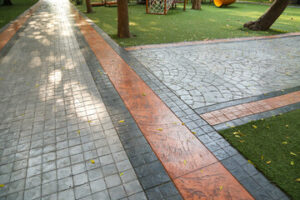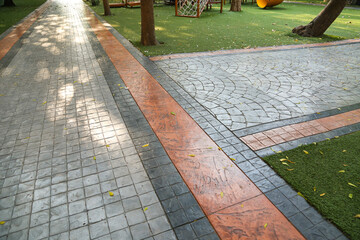Stamped Concrete Charles Town WV is more affordable than other paving materials, such as stone and brick. It is also much more durable and requires less maintenance.
Color is vital to the finished look of your stamped concrete project. Many choices include natural stone patterns and more rustic options like cobblestones or even wood-like textures.
Concrete is often thought of as a utilitarian material, but it can actually be used to create an elegant aesthetic for your home. You can choose from a wide variety of patterns, textures and colors to achieve the desired look. It can even be stamped to look like pricier materials, such as stone. The concrete experts can help you create a unique style for your home that will enhance its curb appeal and increase the value of your property.
The versatility of concrete stamping makes it a perfect choice for walkways, patios and pool decks. It can be designed to look like many different types of materials, including flagstone, brick and natural stone. You can also choose to add a textured surface that resembles slate, wood or pebbles. This will enhance traction and provide a safer surface for walking, especially in wet or slippery conditions.
In addition to the texture, stamped concrete can be colored to match the surrounding landscape or to complement your home’s exterior. You can choose a color that is opaque or translucent, bright or dull, or even create an ombre effect. The options are endless, and you can choose a color that reflects your personal taste.
After the concrete is poured, it can be stamped with a variety of designs. There are a few steps that must be taken to ensure that the design is executed properly. Firstly, you must prepare the concrete for stamping by washing it with a commercial degreaser. Afterwards, the concrete should be sprayed with a liquid release agent. This will help the concrete adhere to the stamp mat and ensure a clean, consistent impression. It is advisable to use a tinted release agent, and to apply it to the concrete a day or two before you start stamping.
Adding texture to the concrete before it is stamped can help you achieve a more realistic and appealing design. If you are using a pattern that requires repeated stamping, it is important to practice on compacted sand to ensure consistency and an accurate representation of the final product. Once you are happy with the results, it is essential to tamp down the skins thoroughly and carefully, and to avoid pattern repetition. After tamping, you should peel back one of the skins to check the concrete’s impression and make any necessary adjustments.
Durability
Concrete is a durable material, but it has limitations. It needs to be properly constructed, and it can crack if it is subjected to excessive pressure or loads. Concrete is also prone to staining, especially when exposed to UV rays. It can also be damaged by salt, a common ingredient in de-icing products.
Stamped concrete can be used in a variety of ways, including patios, driveways, pool decks and more. Its versatility makes it a great choice for homeowners who want a natural-looking surface that is easy to maintain. In addition to its durability and aesthetics, stamped concrete is a cost-effective alternative to pavers and stonework.
The process of installing stamped concrete is complex and requires a skilled contractor. First, the concrete must be poured and allowed to set. Then, the concrete is stamped with a pattern using large, flexible polyurethane stamps. The stamps are typically about 2-by-2 feet and an inch or two thick. The concrete contractor may step on the stamps to press them into the concrete or use a tamping tool. Before putting on the stamp, the contractor should spray the patterned side of the stamp with a release agent that prevents concrete from sticking to it.
Once the concrete is cured, it is sealed to protect it from UV rays and other damage. Sealing is essential for stamped concrete, and it should be done every three to four years. It is important to choose a quality sealant that is designed specifically for decorative surfaces. It should contain resins that enhance color and shine.
One drawback of stamped concrete is that it can crack over time, especially in harsh climates. This can be unsightly and cause tripping hazards. In many cases, cracks in stamped concrete can be fixed by patching or by adding an overlay. However, these repairs can be expensive and difficult to match the original color of the concrete.
While stamped concrete is less likely to crack than paved surfaces like pavers, it will still need routine maintenance. In order to avoid cracks and stains, it is necessary to keep the concrete clean and dry. In addition to cleaning, it is important to reseal the concrete every 3-5 years.
Maintenance
Getting the best out of your stamped concrete requires some care. While this type of concrete is highly durable, it can also be prone to staining and cracking if not treated properly. Fortunately, there are ways to minimize these problems and ensure that your concrete looks great for as long as possible.
To avoid fading, it is important to clean and reseal your stamped concrete regularly. This will help to keep it looking new and reduce the chance of stains. In addition, resealing your stamped concrete will protect it from environmental elements like dirt and rain, which can damage the surface. It is recommended that you reseal your stamped concrete every two years, or sooner if it gets lots of traffic.
When cleaning your stamped concrete, it is important to use a mild cleaner. Never use acid or vinegar, as these can etch the concrete and ruin its appearance. You should also avoid washing your stamped concrete with a pressure washer, as this can strip the sealer and cause it to fade. Instead, a garden hose on a low setting will work just fine.
In the event that you do need to use a cleaning product, it is essential that you test it on a small area of your concrete before using it on the entire surface. Follow the instructions on the label and make sure that you rinse the concrete thoroughly afterward.
If you are considering adding a stamped concrete project to your home, it is critical that you hire a professional. They can help you plan and execute a project that will look great and last for years to come. Moreover, they can help you choose the right color and pattern for your project. In addition, they can help you avoid costly mistakes during installation.
A professional will know how to properly use the stamping mats and will have experience working with various types of concrete. They will also have the equipment necessary to mix and pour the concrete correctly. They will also have access to special admixtures that can be added to the concrete mix to control the rate at which it hardens.
Cost
Stamped concrete is an affordable way to beautify patios, walkways and driveways. Its ability to imitate the look of other more expensive materials like natural stone slabs, tile and brick makes it an attractive alternative for homeowners looking to save money. The cost of stamped concrete varies depending on the size and complexity of the project, as well as labor prices in your area. The more intricate the design, the higher the cost of the project.
A basic stamped concrete design with one color will typically run between $8 and $13 per square foot, while mid-range jobs with borders and contrasting patterns can cost up to $18 per square foot. Larger projects, such as a custom pool deck or curved patio, may require specialized tools and take longer to complete than smaller jobs. For these reasons, it is best to hire a professional to complete the work.
Before beginning the stamping process, contractors will often apply a release agent to the surface of the concrete. This prevents the stamps from sticking to the uncured concrete and helps ensure that the imprinting process is executed correctly. Once the concrete has dried, a coloring and hand-finishing process will be performed.
The final cost of the project will depend on the type and size of the slab, as well as any additional services that the contractor may provide. For example, if the concrete is to be used as a driveway, contractors may recommend adding styrofoam insulation and a vapor barrier to reduce the risk of frost damage. In addition, if the concrete is to be used in a cold climate, they may also recommend adding rebar to strengthen and reinforce the concrete slab.
Once the concrete has been installed, it will need to be maintained regularly in order to retain its luster and appearance. Regular cleaning with mild detergents will help to keep the concrete clean and free from dirt and stains. Additionally, it is a good idea to apply a coat of water-based sealer to the concrete once a year.
If the concrete is exposed to heavy traffic or chemicals, it may need to be resealed more frequently. Resealing will also help to protect the concrete from wear and tear, as well as to prevent moss and algae growth.

